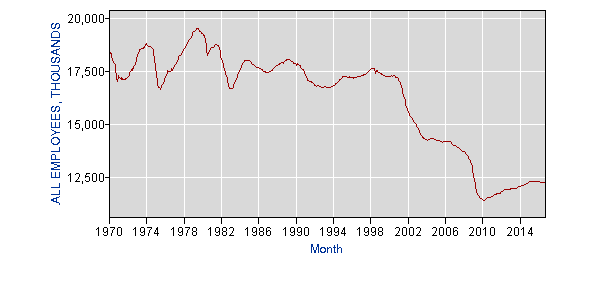Painful Nonsense on Trade
It really is amazing how much effort elite types expend denying that trade has cost us manufacturing jobs. The latest entry is from Robert Samuelson who tells us that it isn't true that manufacturing jobs have been lost to trade. Samuelson's main source on this is Brad DeLong, who is actually a very good economist and surely knows better.
Samuelson tells readers:
"Contrary to popular opinion, trade is not a major cause of job loss. It’s true that U.S. manufacturing has suffered a dramatic long-term employment erosion, sliding from roughly one-third of nonfarm jobs in 1950 to a quarter of jobs in the early 1970s to a little less than 9 percent now, according to economist J. Bradford DeLong of the University of California at Berkeley in an essay posted on Vox. But the main cause is automation."
The cheap trick here is going back to 1950. Yes, we have lost lots of manufacturing jobs to automation and over a 70 year period that does swamp the impact of the jobs lost due to trade, but this is really a dishonest way to present the issue. Manufacturing was declining as a share of total employment even in the 1950s and 1960s, but the pace was modest enough and we were creating enough jobs in other sectors that the job loss still allowed for real wage growth in both manufacturing and the economy as a whole.

What is at issue is the rate of decline, not the fact that manufacturing employment is dropping. The graph below shows the number of manufacturing jobs in the economy since 1970.
Note that the level of manufacturing employment, while it has cyclical ups and downs, is nearly constant from 1970 to 2000 at around 17 million. It plunged in the early years of the last decade as the trade deficit exploded. Most of the fall in employment was before the collapse of the housing bubble in 2008. This is what happens when a trade deficit increases from around 1.5 percent of GDP, the mid-1990s level, to almost 6.0 percent of GDP at its peak in 2005-2006 (over $1.1 trillion in today's economy).
In his article Brad does a bit of slight of hand on this rise in the trade deficit, attributing it to an over-valued dollar rather than trade agreements like NAFTA. I agree with him on this, but I think the ignorant masses can be excused for failing to recognize that the jobs lost to trade were due to the Clinton administration's dollar policy rather than its trade deals.
I would also add that the dollar policy and the trade deficit were central to the imbalances that led to the housing bubble and the collapse that followed. In other words, someone could quite rightly blame our dollar policy for the Great Recession. This is not a small matter.
DeLong also does a bit of slight of hand in telling us that the loss of manufacturing employment is the same everywhere, pointing out that even Germany, the big success story, saw employment in manufacturing fall from about 40 percent of the labor force in 1971 to 20 percent at present. This is true, and if the United States had the same share of its workforce employed in manufacturing as Germany, we would have another 15 million manufacturing jobs. Does anyone think this would not make a difference in the labor market for non-college educated workers?
Then we get Samuelson's push for the Trans-Pacific Partnership (TPP).
"By 2030, U.S. incomes would be 0.5 percent higher and incomes in Vietnam — a big winner — would be 8 percent higher, estimates a study for the Peterson Institute. That modest boost is gone."
If we use the numbers from the less partial International Trade Commission (ITC), the projected gains by 2032 would be 0.21 percent of GDP, a bit more than one month's normal growth. It is worth noting that the widely touted gains to Vietnam from the TPP are almost entirely as result of reducing the country's own trade barriers, something that it can do any day of the week with or without the TPP. (I will gladly take a bet at 10 to 1 odds that Vietnam cuts its tariffs by at least 80 percent before 2030 even if we never do a thing to advance the TPP or replacement pact.)
It is also worth noting that the ITC's projections do not take account of any of the costs associated with stronger and longer patent and copyright protection which would have the citizens of the United States and other member countries paying higher prices for prescription drugs, software, and a wide variety of other products. These protectionist barriers typically raise the price of the covered products by factors of ten or even a hundred, the equivalent of tariffs of 1,000 or 10,000 percent. The losses from these protectionist barriers can easily swamp the modest gains projected by the ITC.
And the TPP came with a set of pro-business regulations locked in place with an extra-judicial tribunal, the investor-state dispute settlement mechanisms, which is only open to foreign investors. These tribunals could effectively over-ride laws at all levels of government intended to protect workers, consumers and the environment. Their rulings are not bound by precedent nor subject to appeal.
In short, the ignorant masses that Samuelson and Brad would lecture about trade had very good cause not to like the agenda. And, when people who should know better insult their intelligence, it shouldn't be surprising that the masses turn to demagogues like Donald Trump who at least pretend to take their concerns seriously.
***
This has been reposted from CEPR.

